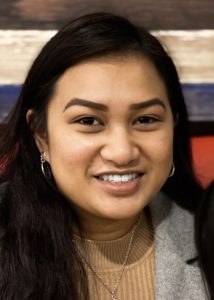Signifyd internships are the best of both worlds: Signifyd interns, for their part, gain an unmatched experience teaming up with top professionals in their chosen fields while working on real-world problems in real-time and with real consequences. Signifyd, for its part, receives the benefit of brilliant students on the cusp of their careers who offer fresh perspective, new ideas and meaningful contributions to Signifyd’s innovation and business success.
But what is it really like to spend a significant amount of time working as an intern at Signifyd? We’re glad you asked. Two Signifyd interns working in our Belfast office — Aira Mae Bayaga and Nathan Nash — sat down for a conversation about the year — the pandemic year — they’ve spent working, learning and living life with colleagues while at Signifyd.
Signifyd intern Aira Mae Bayaga is a Computer Science student at Queen’s University Belfast. This fall she’s returning to complete her final year.
Signifyd intern Nathan Nash is also a Computer Science student at Queen’s. They didn’t know each other before joining Signifyd, starting at the company on the same day. Aira Mae initially joined the IOS Team, Integrations and Onboarding Services, which recently split into two teams due to the domain areas being covered.
Aira Mae is now a member of the Sentry Team (yes, like the Marvel superhero in the comics!) and with her teammates is responsible for all things authentication and authorization. Nathan is part of the PI Team, Payments and Insights, which maintains and develop automated billing for Signifyd’s customers.
Now on to the interview (edited for length and clarity):
Nathan: So, Aira Mae, what were your expectations about the internship going in?
Aira Mae: My main expectation was to get complete exposure to the IT industry, experience the life of a software engineer and to learn as much as I could from the professionals. I aimed to apply what I learned at university and to develop that further.
I definitely wasn’t expecting to be working remotely and for a year. Expectations quickly shifted to concerns — such as whether I would be limited in the work I could partake in and how that would impact what I hoped to gain from this internship. The reality is, I shouldn’t have been worried at all. Instead, I got to be fully immersed in the experience.
Aira Mae: What about you, Nathan?
Nathan: Before starting the internship I had very few expectations about the work that I would be doing, other than that it would likely involve Java and probably meetings. But I had high expectations of Signifyd’s company culture — that it would live up to.
The interview process, which took place after I experienced a pile of ignored applications elsewhere and large group interviews, was refreshingly human with the interview performed by two members of technical staff that genuinely felt like a casual chat instead of the more common interrogation.
One expectation that I had, reasonably I thought, was that the majority of my internship would take place in Signifyd’s shiny office, surrounded by pool tables, free food and my co-workers. This didn’t quite pan out, but the good folks at Signifyd pulled together to help make a remote internship a great alternative.
Nathan: How was the onboarding process, Aira Mae?
Aira Mae: I found it very difficult to begin with as I felt overloaded by the wealth of information. I barely knew where to start. Remote onboarding was both new to me and the team, so we learned together and strived through it. Thanks to my team and their continued support that made this crucial aspect short-lived. They saw to it that I got ramped up quickly.
Apart from picking up the lingo within R&D, there’s a range of areas to learn about, from what makes Signifyd, Signifyd, to their impact and, more interestingly to me, their tech stack — what I’d get to touch on and work with. After the fact, I was excited to get stuck in and start writing code.
Aira Mae: What was your onboarding like?
Nathan: To be honest, it was a lot of new stuff to take in and learn about, just like with joining any new company, and especially true for an intern. On the technical side, I got up to speed on how a ‘planet scale’ system like Signifyd is built and kept in working order.
Personally, I found this to be quite a steep learning curve but I had many helpful people explain the how’s and why’s to me which made the process a lot easier.
And of course, the whole onboarding process happened remotely, but this wasn’t an issue because help was always just a Zoom call away or available in Signifyd’s documentation.
Nathan: When you think about the main day-to-day responsibilities that came along with your internship, what would you list?
Aira Mae: Any given day mainly involves writing, reviewing code, monitoring services, Zoom meetings and drinking coffee. Every day was genuinely a learning opportunity. Learning about the industry processes and emerging technologies whilst solving tasks.
As an agile team, responsibilities and priorities could shift and we’d have to work quickly and efficiently to accomplish the task. Also, being remote meant you were accountable for how your time was spent but you also had complete control over your working environment. Knowing how to facilitate and divide time for the work ahead has helped my productivity.
Aira Mae: How do you think of the day-to-day responsibilities, Nathan?
Nathan: For me, a standard day as a back-end software engineering intern consisted mainly of working on tickets on my team’s Jira board. These tickets defined a specific user requirement that should be added to our system. I would approach these by drafting a design of the proposed changes and sharing them with the broader team to get confirmation that my design was reasonable and likely to work.
From the design I would code the proposed changes, adding or updating tests along the way as required, after which I would again share with the team to get feedback. Finally, the changes would be deployed to the production environment, where users can make use of them. To my surprise, there was more to this than just Java. There is Signifyd’s style of programming (asynchronous CompletionStages, functional programming); assorted libraries (Jooq, Play); as well as the other tools used (gRPC, TeamCity, Gradle).
The remainder of my day would normally be spent helping out teammates by reviewing their change designs and actual code changes for their tickets.
And occasionally I would be the on-call responsible for handling any production alerts for my teams’ deployed services. This was always a good chance to improve my knowledge of our systems and to see how and where certain edge cases arise.
Nathan: So, Aira Mae, what challenges have you faced and how did you overcome them?
Aira Mae: At the start, I had a million questions but held off on a majority of them. I thought they were simple or stupid questions — either way, no one will know. But time granted comfortability and some normalcy, and now I’m not as fazed when constructing a question ready to post on Slack.
Even after months of being at Signifyd, I would sometimes get stumped by the work laid out on a ticket and begin to doubt myself and my abilities. The feeling of not knowing enough to complete a task and not wanting to disappoint the team is an internal challenge I’ve come across many times.
But I’m glad to have known early on that my team are always willing to help me out. Their contribution allowed me to collaborate towards an area that’s no longer out of my realm.
Aira Mae: And you, Nathan, what challenges did you tackle?
Nathan: For me, one of the trickier problems was ramping up on the front-end side of Signifyd, including the different libraries (mostly Typescript with react) and tools (node and npm) being used.
As well, the team and processes used are completely different to what I was used to on the back-end side. With the front end being focused on the visual side, it involved collaborating with the design team on getting things to look just right, which could sometimes mean tweaking some CSS.
Fortunately, and similar to ramping up on the back-end side of things, I was always supported by other team members and had a lot of good resources at my disposal, including the Epic React course. What I found most beneficial was pair programming with another more experienced front-end developer on a problem like a unit test or working out how to solve a difficult problem.
Nathan: How would you describe the company culture?
Aira Mae: From day one, the culture was always inviting and the company continues to ensure that as an employee and an individual that you feel safe, valued and respected.
I particularly want to highlight that as a person of color, I’m not surprised to say that I’ve little to no expectations towards much support on diversity from a company. It’s mostly to tick the box. The sad reality is that this is a pretty common opinion for many. So, I was really shocked to see the outreach that Signifyd provides for its employees in the areas of diversity, equity and inclusion.
They would go through lengths to support each person at their company and beyond. It’s key to highlight that Signifyd has afforded me the assurance and confidence of being in their company as I am. With an environment like this, you’ll be more motivated, pushing you to learn and grow constantly.
Aira Mae: What do you think of the culture, Nathan? What are your observations?
Nathan: We do have some official company values alongside some of the attributes that I’ve seen my coworkers demonstrate: like always being willing to help out with a problem and to jump on a call to pair program. But the main one that appeals to me, as an intern, is ‘curious and hungry,’ which equates to being actively encouraged to try and learn new things.
I was encouraged to try some time working on the front-end side and was even encouraged to try some DevOps work (which I’ve turned down for now at least).
One unique part of Signifyd’s culture is that they seem to genuinely care about their employees and their employee’s mental health, alongside the more common meditation and yoga classes, they have for the summer been trialing giving R&D every other Friday off to rest and enjoy the summer. And the additional time-off concept has now been extended to the rest of the company in the form of six additional days off for Q4!
Nathan: OK, big question, Aira Mae. What have you gained from this internship?
Aira Mae: I’ve gained invaluable experience and knowledge which are key structures to grow my career and become a professional. My expectations have been exceeded as Signifyd provides me with a platform where the opportunities are endless for personal progression and to boost employability. I’ve achieved accomplishments from my role as a software engineering intern and more. Everything I’ve learned, I’ll be able to take away with me wherever my career lands me.
This internship has truly opened doors for me that I’ll be forever grateful for. Before returning to university, I’ve been offered an extension to work part-time during my final year and a graduate position. Overall, my career journey is still very early on but having completed a year at Signifyd, it’s been filled with everything you’d want at an internship.
Aira Mae: And what about you? What have you gained in the last year or so?
Nathan: To sum it all up, I’ve gained some very valuable technical skills, both on the back-end and front-end side, as well as a new understanding of the infrastructure/DevOps side. And to top it off I’ve been offered an extension to work part-time during my final year, too, and a graduate position at what I think is a great place to work.
Nathan: Any final thoughts, Aira Mae?
I think you’ll agree, Nathan, that our internship experiences have spoken volumes to us. But as we’ve said throughout, our progression has been aided by the support of those at the company and especially by our teams. They’ve helped shape the experience into what it is. If there’s one thing to take away from this, it’s that doing an internship will undoubtedly set you up for your career path, making those important connections and experiences.
Signifyd interns Aira Mae Bayaga and Nathan Nash reported this story. Photos by Signifyd
Interested in joining a fast-moving, close-knit team? Explore your future at Signifyd










